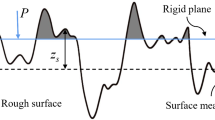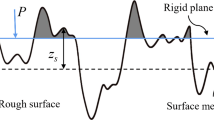Abstract
An improved elastic contact model for a single asperity system is proposed accounting for both the effects of bulk substrate and asperity deformations. The asperity contact stiffness is based on the Hertzian solution for spherical contact, and the bulk substrate stiffness on the solution of Hertzian pressure on a circular region of the elastic half-space. Depending on the magnitude of the applied load, as well as the geometrical and physical properties of the asperity and bulk materials, the bulk substrate could have considerable contribution to the overall contact stiffness. The proposed single asperity model is generalized using two parameters based on physical and geometrical properties, and is also verified using finite element analysis. A parametric study for a practical range of geometric and physical parameters is performed using finite element analysis to determine the range of validity of the proposed model and also to compare it with the Hertz contact model. The single asperity model is extended to rough surfaces in contact and the contact stiffness from the proposed model and the simpler Greenwood–Williamson asperity model are compared to experimental measurements.












Similar content being viewed by others
Abbreviations
- A n :
-
Nominal contact area
- A r :
-
Real contact area (rough surface contact)
- d :
-
Separation based on asperity heights (rough surface contact)
- E :
-
Effective elastic modulus between asperity and bulk substrate
- E a :
-
Asperity effective elastic modulus
- E asperity :
-
Asperity elastic modulus
- E b :
-
Bulk substrate effective elastic modulus
- E bulk :
-
Bulk substrate elastic modulus
- F :
-
Contact force
- F Hertz :
-
Contact force computed based on Hertz model
- g :
-
Generalized function
- H :
-
Hardness
- h a :
-
Asperity height
- h :
-
Separation based on surface heights (rough surface contact)
- K :
-
Hardness coefficient
- k :
-
Composite spring constant between asperity and bulk substrate
- k a :
-
Asperity spring constant
- k b :
-
Bulk substrate spring constant
- k r :
-
Contact stiffness in rough surface contact
- P c :
-
Contact force (rough surface contact)
- p 0 :
-
Maximum contact pressure
- R :
-
Asperity radius
- r :
-
Radial distance from the center of contact
- r b :
-
Radius of circular contact region on top of bulk substrate
- U z :
-
Normal displacement of the contact surface
- u :
-
Asperity height measured from the mean of asperity heights
- δ :
-
Normal applied displacement (or surface approach)
- δ a :
-
Asperity deformation
- δ b :
-
Bulk substrate deformation
- η :
-
Areal density of asperities
- κ :
-
Physical index parameter
- ν a :
-
Asperity Poisson’s ratio
- ν b :
-
Bulk substrate Poisson’s ratio
- ξ :
-
Geometrical index parameter
- σ :
-
Standard deviation of asperity heights
- ϕ :
-
Distribution function of asperity heights
- ω :
-
Surface interference
- ω c :
-
Critical interference at the inception of plastic deformation
References
Patton, S.T., Zabinski, J.S.: Failure mechanisms of capacitive MEMS RF switch contacts. Tribol. Lett. 19(4), 265–272 (2005)
Suh, A.Y., Polycarpou, A.A.: Adhesion and pull-off forces for polysilicon MEMS surfaces using the sub-boundary lubrication model. ASME J. Tribol. 125, 193–199 (2003)
Lee, S.-C., Polycarpou, A.A.: Microtribodynamics of pseudo-contacting head-disk interfaces intended for 1 Tbit/in2. IEEE Trans. Mag. 41(2), 812–818 (2005)
Barber, J.R., Ciavarella, M.: Contact mechanics. Int. J. Solids Struct. 37, 29–43 (2000)
Greenwood, J.A., Williamson, B.P.: Contact of nominally flat surfaces. Proc. R. Soc. Lond. A 295, 300–319 (1966)
Chang, W.R., Etsion, I., Bogy, D.B.: An elastic-plastic model for the contact of rough surfaces. ASME J. Tribol. 109, 257–263 (1987)
Kogut, L., Etsion, I.: Elastic-plastic contact analysis of a sphere and a rigid flat. ASME J. Appl. Mech. 69, 657–662 (2002)
Greenwood, J.A., Wu, J.J.: Surface roughness and contact: an apology. Meccanica 36, 617–630 (2001)
McCool, J.I.: Comparison of models for the contact of rough surfaces. Wear 107, 37–60 (1986)
Shi, X., Polycarpou, A.A.: Measurement and modeling of normal contact stiffness and contact damping at the meso scale. ASME J Vib. Acoust. 127, 52–60 (2005)
Suh, A.Y., Mate, C.M., Payne, R.N., Polycarpou, A.A.: Experimental and theoretical evaluation of friction at contacting magnetic storage slider-disk interface. Tribol. Lett. 23–3, 177–190 (2006)
Archard, J.F.: Elastic deformation and the laws of friction. Proc. R. Soc. Lond. A 243, 190–205 (1957)
Majumdar, A., Bhushan, B.: Fractal model of elastic–plastic contact between rough surfaces. ASME J. Tribol. 113, 1–11 (1991)
Sahoo, P., Roy Chowdhury, S.K.: A fractal analysis of adhesive friction between rough solids in gentle sliding. Proc. Inst. Mech. Eng. Part J: J Eng. Tribol. 214, 583–595 (2000)
Komvopoulos, K., Yan, W.: Three-dimensional elastic–plastic fractal analysis of surface adhesion in microelectromechanical systems. ASME J. Tribol. 120, 808–813 (1998)
Suh, A.Y., Polycarpou, A.A., Conry, T.F.: Detailed surface roughness characterization of engineering surfaces undergoing tribological testing leading to scuffing. Wear 255, 556–568 (2003)
Mbise, G.W., Niklassont, G.A., Granqvist, C.G.: Scaling of surface roughness in evaporated calcium fluoride films. Solid State Commun. 97, 965–969 (1996)
Siegert, M., Plischke, M.: Slope selection and coarsening in molecular beam epitaxy. Phys. Rev. Lett. 73, 1517–1520 (1994)
Hui, C.Y., Lin, Y.Y., Baney, J.M., Kramer, E.J.: The mechanics of contact and adhesion of periodically rough surfaces. J. Polym. Sci. Part B: Polym. Phys. 39, 1195–1214 (2001)
Jeng, Y.-R., Aoh, J.-H., Wang, C.-M.: Thermosonic wire bonding of gold wire onto copper pad using the saturated interfacial phenomena. J. Phys. D Appl. Phys. 34, 3515–3521 (2001)
Suh, A.Y., Lee, S.-C., Polycarpou, A.A.: Adhesion and friction evaluation of textured slider surfaces in ultra-low flying head-disk interfaces. Tribol. Lett. 17(4), 739–749 (2004)
Iida, K., Ono, K.: Design consideration of contact/near-contact sliders based on a rough surface contact model. ASME J. Tribol. 125, 562–570 (2003)
Shi, X., Polycarpou, A.A.: Investigation of contact stiffness and contact damping for magnetic storage head-disk interfaces. ASME J. Tribol. 130, 021901-1-9 (2008)
Johnson, K.L.: Contact Mechanics. Cambridge University Press, Cambridge (1985)
Acknowledgments
This research was supported by grants from the National Science Foundation under Grant number CAREER CMS-0239232 and the Information Storage Industry Consortium (INSIC) EHDR Program. The roughness measurements were performed at the Center for Microanalysis of Materials at the University of Illinois, which is supported by the U.S. Department of Energy under Grant DEFG02-96-366 ER45439.
Author information
Authors and Affiliations
Corresponding author
Rights and permissions
About this article
Cite this article
Yeo, CD., Katta, R.R. & Polycarpou, A.A. Improved Elastic Contact Model Accounting for Asperity and Bulk Substrate Deformation. Tribol Lett 35, 191–203 (2009). https://doi.org/10.1007/s11249-009-9448-0
Received:
Accepted:
Published:
Issue Date:
DOI: https://doi.org/10.1007/s11249-009-9448-0




